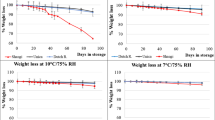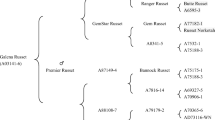Abstract
Russet Burbank is the predominant potato (Solanum tuberosum L.) cultivar grown and stored for fresh market and frozen processing (French fry) use in North America. Multi-year assessments of potato tuber quality under different storage regimes can provide information about a cultivar’s ability to retain process quality when challenged with seasonal variations across multiple years. The objective of a 15-year study initiated in 1999 was to evaluate the quality of Russet Burbank tubers grown and stored at the Kimberly Research and Extension Center. Potatoes were measured for specific gravity at harvest and stored for eight months under three temperatures (5.6, 7.2 and 8.9 °C) and periodically sampled throughout the storage season to determine dormancy length, sugar content, fry color and mottling severity (a quality issue), and weight loss. The year in which the crop was grown significantly (p < 0.001) affected all quality characteristics except specific gravity (average ranged between 1.071 and 1.081). Tubers held during the 2011–2012 and 2013–2014 storage seasons exhibited generally higher glucose, darker fry color, more severe mottling, and higher weight loss. Average sucrose content at 7.2 °C and 8.9 °C across the 15 years significantly decreased over the eight-month storage while average glucose content remained consistent after first month of storage. Average percent weight loss across the 15 years was 6.1 % after eight months in storage. This 15-year study emphasized that variation of post-harvest storage quality from year to year was likely a result of variable seasonal growing conditions. Storage temperatures between 7.2 and 8.9 °C were the optimum range for storing fry processing Russet Burbank potatoes and the warmer temperature of 8.9 °C appears to ameliorate the seasonal effects on glucose content and fry color to maintain better processing quality throughout storage.
Resumen
Russet Burbank es la variedad predominante de papa (Solanum tuberosum L.) que se cultiva y se almacena paras mercado fresco y procesamiento congelado (papas a la francesa) en Norteamérica. Evaluaciones multianuales de la calidad del tubérculo de papa bajo diferentes regímenes de almacenamiento pueden proporcionar información acerca de la habilidad de una variedad para retener la calidad de proceso cuando se le enfrenta a variaciones de ciclos de cultivo a lo largo de muchos años. El objetivo de un estudio de 15 años, iniciado en 1999 fue evaluar la calidad de los tubérculos de Russet Burbank cultivados y almacenados en el Centro Kimberly de Investigación y Extensión. A las papas se les cuantificó la gravedad específica a la cosecha y se almacenaron por ocho meses bajo tres temperaturas (5.6, 7.2, y 8.9 °C) y se muestrearon periódicamente a lo largo del período de almacenamiento, para determinar la longitud de la dormancia, contenido de azúcar, color del freído, severidad de moteado (un aspecto de calidad), y pérdida de peso. El año en el que creció el cultivo afectó significativamente (p < 0.001) todas las características de calidad excepto la gravedad específica (el promedio fluctuó entre 1.071 y 1.081). Los tubérculos de los períodos de almacenamiento 2011–2012 y 2013–2014, exhibieron generalmente glucosa más alta, color más oscuro de freído, moteado más severo y pérdida de peso más alta. El contenido promedio de sacarosa a 7.2 °C y 8.9 °C a lo largo de los 15 años disminuyó significativamente sobre el almacenamiento de ocho meses, mientras que el contenido promedio de glucosa permaneció consistente después del primer mes de almacenamiento. El promedio de porcentaje de pérdida de peso a lo largo de los 15 años fue 6.1 % después de ocho meses en almacén. Este estudio de los 15 años enfatizó que la variación de la calidad en el almacenamiento postcosecha de año a año era probablemente el resultado de las variaciones estacionales de las condiciones de crecimiento. Las temperaturas de almacenamiento entre 7.2 °C y 8.9 °C fueron la amplitud óptima para procesamiento de frituras de papas Russet Burbank, y las temperaturas más cálidas de 8.9 °C parecen mejorar los efectos estacionales del contenido de glucosa y color de freído para mantener mejor calidad de proceso a lo largo del almacenamiento.


Similar content being viewed by others
Abbreviations
- LTS:
-
Low-temperature sweetening
- FW:
-
Fresh weight
References
Amer, F.S., L. Reddivari, G.P. Madiwale, M. Stone, D.G. Holm, and J. Vanamala. 2014. Effect of genotype and storage on glycoalkaloid and acrylamide content and sensory attributes on potato chips. American Journal of Potato Research 91: 632–641.
Bethke, P. 2014. Ethylene in the atmosphere of commercial potato (Solanum tuberosum) storage bins and potential effects on tuber respiration rate and fried chip color. American Journal of Potato Research 91: 688–695.
Boe, A., G. Woodbury, and T. Lee. 1974. Respiration studies on Russet Burbank potato tubers—effects of storage temperature and chemical treatments. American Potato Journal 51: 355–360.
Bogucki, S., and D. Nelson. 1980. Length of dormancy and sprouting characteristics of 10 potato cultivars. American Potato Journal 57: 151–157.
Brandt, T., Olsen, N., and Kleinkopf, G. 2009. Effect of growing season on ‘Russet Burbank’ storage tuber quality. American Journal of Potato Research 86: 138.
Bussan, A., R. Sabba, and M. Drilias. 2009. Tuber maturation and potato storability: optimizing skin set; sugars; and solids. Madison: University of Wisconsin-Extension, Cooperative extension.
Castleberry, H., and Jayanty, S. 2012. An experimental study of pressure flattening during long-term storage in four russet potato cultivars with differences in at-harvest tuber moisture loss. American Journal of Potato Research 89: 269–276.
Coleman, W., Li, X., Tremblay-Deveau, E., and Coleman, S. 2003. Chemical maturation and storage performance of eleven Russet Burbank clones. Canadian Journal of Plant Science 83: 893–902.
Cunningham, H., M. Zaehring, and W. Sparks. 1971. Storage temperature for maintenance of internal quality in Idaho Russet Burbank potatoes. American Potato Journal 48: 320.
Daniels-Lake, B., R.J.N. Prange, S. Asiedu, and J. Walsh. 2005. Sprout development and processing quality changes in potato tubers stored under ethylene: 1. effects of ethylene concentration. American Journal of Potato Research 82: 389–397.
Driskill, E., Knowles, L., and Knowles, N. 2007. Temperature-induced changes in potato processing quality during storage are modulated by tuber maturity. American Journal of Potato Research 84: 367–383.
Foukaraki, S., Cools, K., Chope, G., and Terry, L. 2014. Effect of the transition between ethylene and air storage on post-harvest quality in six UK-grown potato cultivars. Journal of Horticulture Science Biotechnology 89: 599–606.
Iritani, W., and W. Sparks. 1985. Potatoes storage and quality maintenance in the Pacific Northwest. Cooperative Extension of Washington State University.
Iritani, W., and L. Weller. 1976. Influence of early storage (pre-holding) temperatures on sugar accumulation in Russet Burbank potatoes. American Potato Journal 53: 159–167.
Isherwood, F. 1976. Mechanism of starch-sugar interconversion in Solanum tuberosum. Phytochemistry 15: 33–41.
Kincaid, D., Westermann, D., and Trout, T. 1993. Irrigation and soil temperature effects on Russet Burbank quality. American Potato Journal 70: 711–723.
Kleinkopf, G., and Olsen, N. 2003. Storage management. In J. Stark, & S. Love, Potato production systems (p. 369). Moscow, ID: University of Idaho Agricultural Communications.
Kleinkopf, G., Westermann, D., Wille, M., and Kleinschmidt, G. 1987. Specific gravity of Russet Burbank potatoes. American Potato Journal 64: 597–587.
Kyriacou, M., Ioannides, I., Gerasopoulos, D., and Siomos, A. 2009. Storage profiles and processing potential of four potato (Solanum tuberosum L.) cultivars under three storage temperature regimes. Journal of Food Agriculture Environment 7: 31–37.
Lammerink, J. 1989. Response of the processing quality of ptoato cultivars to long-term storage conditions. New Zealand Journal of Crop Horticulture Science 17: 61–65.
Love, S., R. Novy, D. Corsini, and P. Bain. 2003. Variety selection and management. In Potato production systems, eds. Stark J., and S. Love, 29. Moscow, ID: University of Idaho Agricultural Communications.
Matsuuro-Endo, C., kobayashi, A., Noda, T., Takigawa, S., Yamauchi, H., and Mori, M. 2004. Changes in sugar content and activity of vacuolar acid invertase during low-temperature storage of potato tubers from six Janpanese cultivars. Journal of Plant Research 117: 131–137.
Muttucumaru, N., Powers, S., Elmore, J., Mottram, D., and Halford, N. 2015. Effects of water availability on free amino acids, sugars, and acrylamide-forming potential in potato. Journal of Agricultural Food Chemistry 63: 2566–2575.
Rak, K., F. Navarro, and J. Palta. 2013. Genotype × storage environment interaction and stability of potato chip color: implications in breeding for cold storage chip quality. Crop Science 53: 1944–1952.
Rommens, C., Ye, J., Richael, C., and Swords, K. 2006. Improving potato storage and processing characteristics through all-native DNA transformation. Journal of Agricultural Food Chemistry 54: 9882–9887.
Schippers, P. 1971. The relation between storage conditions and changes in weight and specific gravity of potatoes. American Potato Journal 48: 313–319.
Sonnewald, S., and Sonnewald, U. 2014. Regulation of potato tuber sprouting. Planta 239: 27–38.
Sparks, W. 1973. Influence of ventilation and humidity during storage on weight and quality changes of Russet Burbank potatoes. Potato Research 16: 213–223.
Stark, J., and S. Love. 2003. Potato production systems. Moscow: University of Idaho Press.
Stevenson, W., R. Loria, G. France, and D. Weingartner. 2001. Compendium of potato diseases. St Paul: The American Phytopathological Society.
Thompson, A., S. Love, J. Sowokinos, M. Thornton, and C. Shock. 2008. Review of the sugar end disorder in potato (Solanum tuberosum, L.). American Journal of Potato Research 85: 375–386.
Thornton, M., W. Buhrig, and N. Olsen. 2010. The relationship between soil temperature and sugar ends in potato. Potato Research 53: 289–296.
USDA, NASS-Northwest Regional Field Office 2014. Potato variety. Olympia, WA.
Viola, R., Davies, H., and Chdek. 1991. Pathway of starch and sucrose biosynthesis in developing tubers of potato (Solanum tuberosum L.) and seeds of faba bean (Vicia faba L.). Elucidation by 13C NMR spectroscopy. Planta 183: 202–208.
Yang, J., J. Powers, T. Boylston, and K. Weller. 1999. Sugars and free amino acids in stored Russet Burbank potatoes treated with CIPC and alternative sprout inhibitors. Journal of Food Science 64: 592–596.
Zaehringer, M., Cunningham, H., and Sparks, W. 1966. Sugar content and color of Russet Burbank potatoes as related to storage temperature and sprout inhibitors. American Potato Journal 43: 305–314.
Zommick, D., L. Knowles, M. Pavek, and N. Knowles. 2014. In‐season heat stress compromises postharvest quality and low‐temperature sweetening resistance in potato (Solanum tuberosum L.). Planta 239: 1243–1263.
Acknowledgments
The authors thank Dr. Gale Kleinkopf, an emeritus professor at the Kimberly R&E Center of University of Idaho, for initiating this study, and support staff at KREC for providing field and lab work assistance. The authors also thank the Idaho Potato Commission and Northwest Potato Consortium for providing funds for the project.
Author information
Authors and Affiliations
Corresponding author
Rights and permissions
About this article
Cite this article
Wang, Y., Brandt, T.L. & Olsen, N.L. A Historical Look at Russet Burbank Potato (Solanum tuberosum L.) Quality Under Different Storage Regimes. Am. J. Potato Res. 93, 474–484 (2016). https://doi.org/10.1007/s12230-016-9524-6
Published:
Issue Date:
DOI: https://doi.org/10.1007/s12230-016-9524-6




